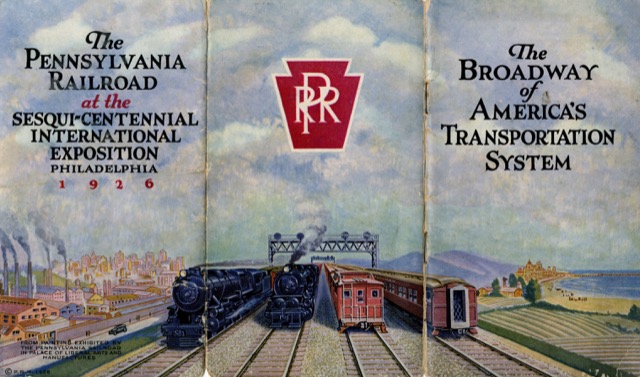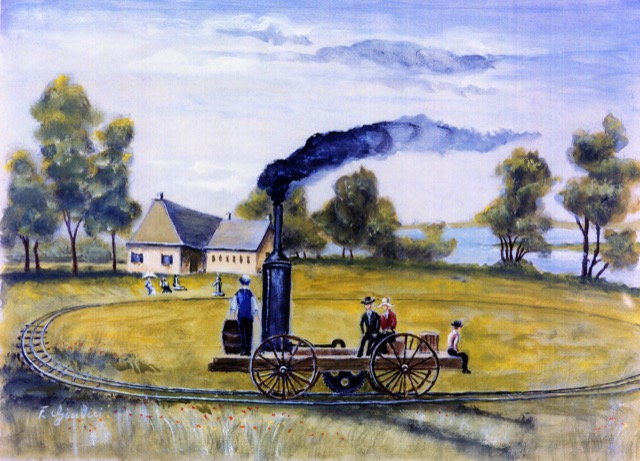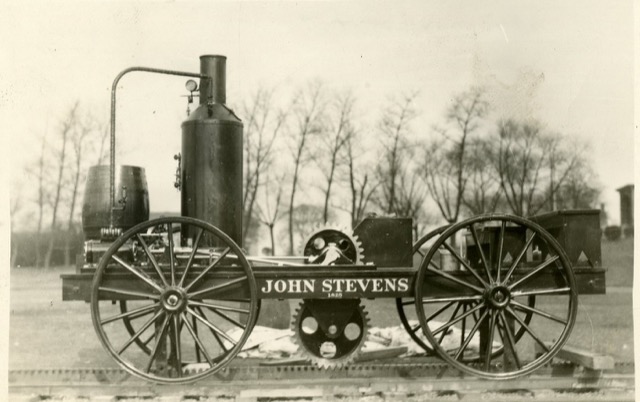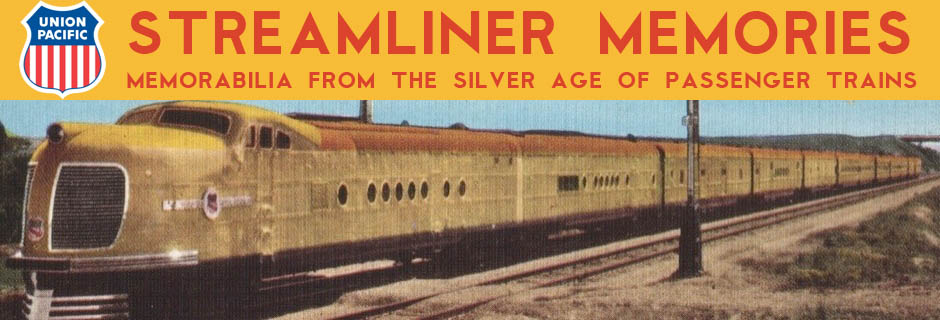In 1926, the Pennsylvania Railroad carried the most traffic and earned the most profits of any railroad in the United States and, probably, the world. It was also headquartered in Philadelphia, so naturally it had an exhibit at the nation’s Sesqui-Centennial Exposition that was held in Philadelphia in that year. This booklet tells about that exhibit.
 Click image to download a 3.9-MB PDF of this booklet.
Click image to download a 3.9-MB PDF of this booklet.
One of the things on exhibit was a model of an early steam locomotive that Pennsylvania had built in 1925. Many people think the first steam locomotive in America was the Stourbridge Lion, which was built in England and imported to the United States in 1829. Many people are wrong.

John Stevens’ track in Hoboken where he demonstrated the first steam locomotive in America. Picture courtesy of the Stevens Institute of Technology, Hoboken.
In fact, the first steam locomotive in America was designed and built in 1825 by John Stevens, who later founded the Camden and Amboy Railroad, the earliest predecessor of the Pennsylvania. Stevens believed that canals were a waste of money because they would soon be replaced by steam trains. To prove it, he built and operated a steam locomotive on a circular track he laid in Hoboken, a farm he owned in New Jersey that he was subdividing into a suburb of New York City. He had previously connected Hoboken with New York with a steam-powered ferry driven by the first screw propellor ever made that was also his invention.

The Pennsylvania’s 1928 replica of John Stevens’ first locomotive, which is now in (and photograph courtesy of) the Stevens Institute of Technology, Hoboken.
As can be seen in the above photo, the locomotive propelled itself by turning a gear that was connected to a toothed track between the two main tracks. Today such cog railroads are still used for steep grades in Switzerland and a few other places. Instead of flanges, the locomotive had little rollers hidden behind each wheel to keep it on the tracks. The main tracks were small iron bars that were square in cross section; the T-shaped rails used today would not be invented until 1830 by John Stevens’ son, Robert Stevens, who was president of the Camden and Amboy Railroad as his father was by then 81 years old.
This bit of forgotten history is told in this booklet, which never mentions the Camden and Amboy but instead claims Stevens as the founder of the Pennsylvania Railroad itself. This little rewrite of history shouldn’t have been necessary to serve the egos of the people who ran the Standard Railroad of the World, but they did it anyway.
Although the model displayed in 1926 was small, perhaps 1/24th scale, in 1928 PRR’s Altoona Shops built a full-sized replica. In that year, the Stevens Institute of Technology, which had been founded by another of John Stevens’ sons, Edwin Stevens, inaugurated its third president. In honor of the occasion, the replica locomotive was displayed and operated on 650 feet of track at the institute.
In 1933, PRR shipped the replica to Chicago to display at the Century of Progress Exposition. After the expo ended, the replica became a part of the Chicago Museum of Science and Industry’s permanent collection. But in 2015, the museum sold it at auction for $66,000, and the purchaser donated it to the Stevens Institute, and it is now on display in the institute’s Williams Library.
In 1939, PRR made another replica of the locomotive to display at the New York World’s Fair. Apparently, it was less trouble to build a second one than to borrow the first one from the Chicago Museum. The 1939 replica is now on display at the Pennsylvania State Railroad Museum.
